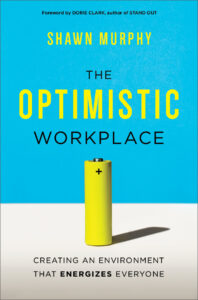Make Work Happy
Do you want to create an optimistic workplace?
How does a strong purpose help in difficult times?
How do leaders set a positive leadership presence?
My friend, author and speaker Shawn Murphy is the CEO & Founder of the leadership blog, Switch & Shift. His new book, The Optimistic Workplace, is a guide to creating and maintaining a powerful, positive, optimistic culture that creates results.
Previously, Shawn shared with us the powerful implications of positive, contagious emotions. I wanted to go deeper into the research for his new book, and so I asked Shawn to share more about the leadership insights he gained from decades of working with business leaders.
Find Your Purpose
I was fascinated by the research on eyeblinks. How does the eyeblink reflex relate to purpose?
Researchers used startle probes to measure the reflexive eyeblink caused by a stimulus, in the case of this research it was an image. The images ranged from positive, to neutral, to negative.
What researchers learned was the length of the eyeblink gave insight into the person’s emotional response to the pictures. The longer the eyeblink, the more unpleasant the response to the picture.
How this connects to purpose is that the researchers, Carol Ryff and team, found that those who had a clearer sense of purpose in life recovered faster from negative images. The research gets at a person’s resiliency. Purpose in life strengthens the core of our identity. The clearer our sense of purpose, the stronger our resiliency is; we can recover faster from negative stimulus in our life.
In a work context, we can summon our purpose to guide us through difficult times at work. It can also help us make better decisions, as purpose serves as a guide in decision making: Does this opportunity support my purpose?
Start Small to Cultivate Optimism
To cultivate optimism in the workplace, you say, “Start small,” and, “Forget about the ‘big bang.’” Most people who have a passion for culture want to jump right in with sweeping initiatives and major change. Why start small?
In my 20+ years as an organizational change management consultant and in leading change in my own company, I’ve learned that the big bang causes more confusion, comes across as rah-rah, and alienates people from what the change purpose and message is.
So, rather go for broke, start small. Create a pocket of excellence. The change starts in a small group within the organization. The group is typically a supporter of the change. Let the small group experience success and gradually widen it to other pockets within the company.
Word of the success travels through networks of people. This approach organically builds support through achieved success and not through possible success. It’s the latter that is the focus of big bang change efforts. It’s what disillusions people about change efforts.
You visited Luck Companies and one of my very favorite restaurants, Zingerman’s. What did you learn from some of these unique cultures that applies to other environments?
I love this question. I started the research with an assumption that the cultures at Luck and Zingerman’s centered on a people-first mindset. I learned that my assumption was only partially right. These cultures had a more dynamic mindset built. They were driven by a purpose important to the company. Employees were doing work meaningful to them. And the organizations attracted and hired extraordinary people.
Other companies can explore what these three variables mean to them and update their hiring practices, for example. Leaders can spend time clarifying purpose and learning what meaningful work looks like to each person on their team.
The other insight from studying Luck, Zingerman’s, 15Five, HopeLab and all the others was this fundamental belief: Treat people like mature, fully functioning adults. Each of these companies have a high-performance culture. They have climates that assist employees in doing their best work. Central to this is the fundamental belief.
How to Set a Positive Leadership Presence
Setting a positive leadership presence is important to all leaders. What practices do you observe in those who do this well?
Through my research and reading lots of leadership literature, I uncovered two groups of leadership practices important to presence: Know Yourself and Do Good for Others.
Know Yourself practices (and skills) center on growing your own awareness of who you are—values and purpose—and knowing the impact you have on people, the culture, and the climate. This includes leadership practices of reflection, values identification, and making sense of situations with as little ego as possible.
Do Good for Others practices center on giving and helping others aim to make life better for other human beings. A major practice is noticing: noticing what is important to others, how people respond to others and situations, etc. Another practice is helping people have clarity in their work through prioritization, knowing what’s important at all times.
Avoid these Missteps
What are some of the missteps and mistakes in building a positive, optimistic workplace?
It is possible to have too much optimism in the workplace. It can blind a team or a leader from dealing with performance problems, creating a Country Club Effect. This is when it feels good to belong to a group, but there is little accountability to the group. This is a bad combination for performance.
I’ve seen organizations want to manipulate a story by focusing only on the positive aspects. This approach can surface when a leader wants to maintain a (false) sense of optimism. It also can surface when a leader is in denial about threats to a climate of optimism.
What makes optimism a powerful influence on people and performance is that it emerges through honesty and respect.
How to Boost Collaboration
What’s the difference between cooperation and collaboration? How do you boost collaboration?
We’ve learned a lot about cooperation through the social sciences. What we’ve learned about cooperation is that two parties come together to achieve something that benefits each of them exclusively. In other words, there is no shared benefit. It’s a short term exchange of resources and people but with little interest in what the other wants or needs.
Collaboration, however, is when groups of people or two people come together who have their own needs and have a shared interest. There’s more of an emotional investment when people collaborate.
To boost collaboration, consider these actions:
- Send employees to learn other parts of the company’s business.
- Screen for collaborative tendencies during new-hire interviews.
- Create shared workspaces that allow for people to collaborate.
- Focus on relatedness by having group events and celebrations. This reinforces relationship building and understanding of other people and groups.
- Make time for face-to-face meetings.
Outside of this great new book, you have a successful leadership blog. What have you learned from blogging and social media? Anything happen that you didn’t expect because of it?
 My social media mentor, Alejandro Reyes, taught me that you need to build a community before you ask for something from them. Otherwise it will be a transaction and not a relationship.
My social media mentor, Alejandro Reyes, taught me that you need to build a community before you ask for something from them. Otherwise it will be a transaction and not a relationship.
Blogging led me to write my first book. It helped shape my thinking and discover my message. It forces you to think through what you believe and why. It’s a great way to examine who you are and what you believe.
The biggest surprise from blogging and social media is the increased confidence in my work. Social media and blogging were means to express myself. I found a tribe who shares similar interests. This was unexpected and a welcome surprise.
The Optimistic Workplace

